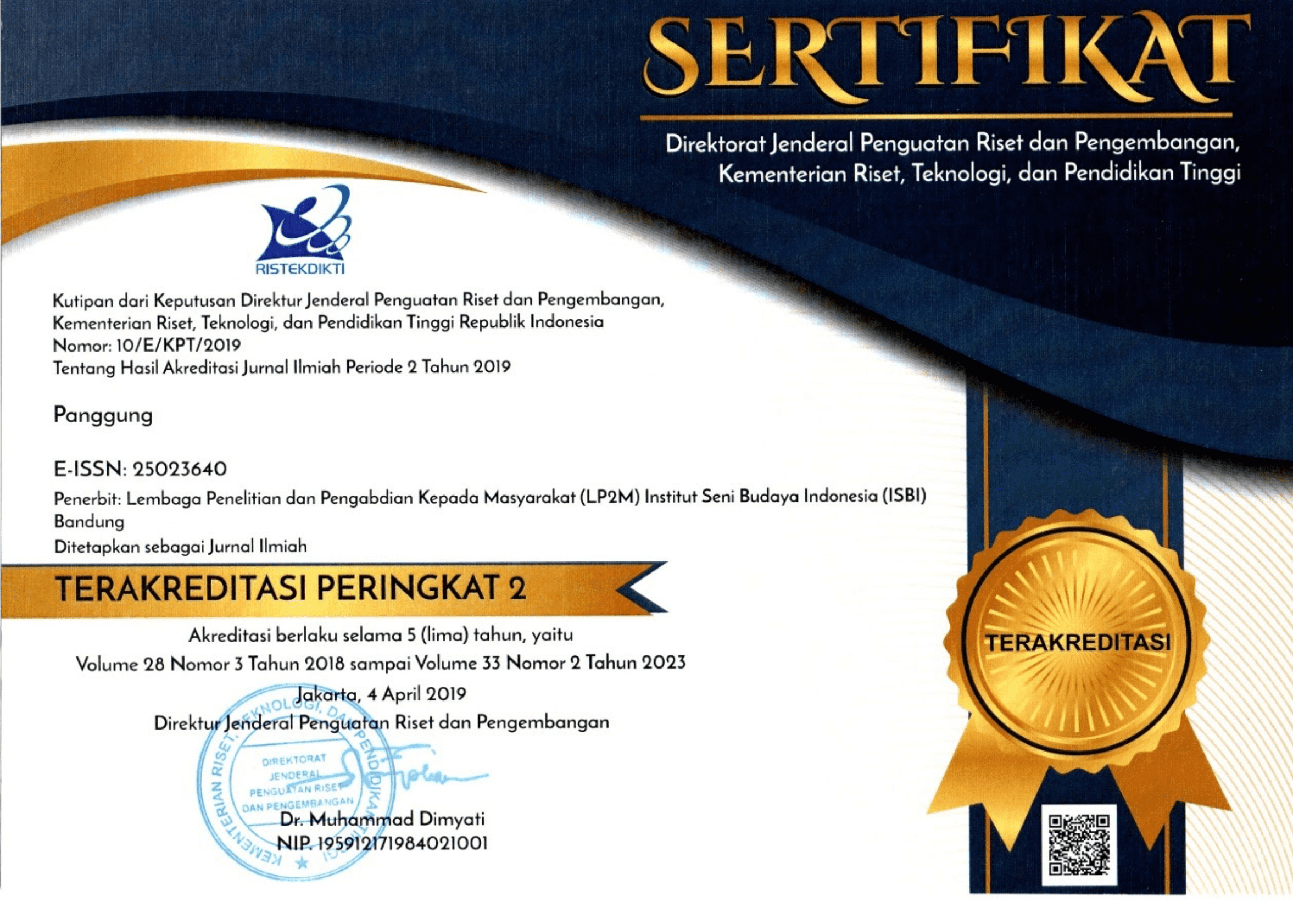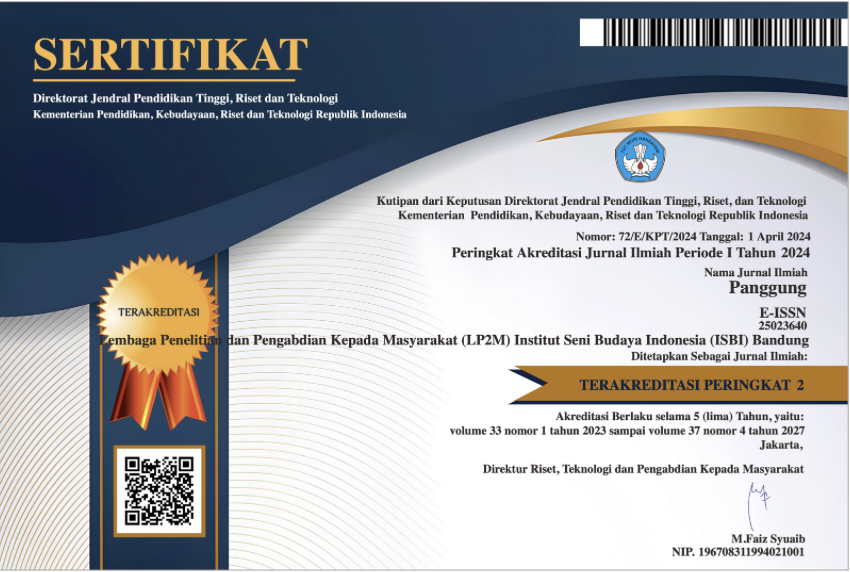Estetika, Seren taun Antara Seni, Ritual, Dan Kehidupan
DOI:
https://doi.org/10.26742/panggung.v26i4.212Abstract
Â
ABSTRACT
Â
Seren taun presents a ceremony system which has aspects of ideas, aspect of language, aspect of behaviour and aspect of equipments. These aspects is related to one another and understood as a sacred communication. Three life principles as the conditions to achieve as the perfection of life and The Truth of death is ritualized on the Pwahaci as the birth symbol, the priciple of maturity and the image of per- fection (death).
Under Djati Kusumah leaderships, Seren taun was developing physically as well as the content of appreciation presentation of the ADS spiritual, be able to be accepted by the community. SerenTaun is seen as guidance of aesthetical beauty in the trilogy of verum, bonum, and pulchrum. Beautiful ways to present aesthetic of Seren taun which is anticipate the nature beauty and art as the safety signs, there are shown by the guidance of the harmonization between human beings and God, the nature and other human beings. The art and ritual performance are kinds and true gives the universal as the harmoniza- tion and balance of humans’lives physically and mentally.
Â
Keywords: Seren taun, ritual performance, aesthetic of beauty, and balancing of humans’lives
Â
Â
Â
Â
Â
ABSTRAK
Â
Seren taun merupakan presentasi estetik masyarakat agraris untuk mendatangkan berkah dari leluhur. Sistem upacara meliputi aspek gagasan, kebahasaan, prilaku, dan peralatan dalam seren taun dimaknai sebagai komunikasi sakral. Tiga prinsip kehidupan sebagai syarat menca- pai kesempurnaan hidup diritualisasikan pada Dewi Pwahaci untuk mengungkapkan tentang prinsip kelahiran, kedewasaan, dan gambaran prinsip kesempurnaan (kematian).
Di tangan Kekarismatikan pemimpin tradisional Pangeran Djati Kusumah, Seren taun berkembang baik secara bentuk maupun isi, sebagai  presentasi penghayatan ajaran spiritual ADS, agar mudah diterima oleh semua orang. Pemahaman itu menunjukan Seren taun sebagai tuntunan nilai-nilai keindahan, yang syarat dengan trilogi antara verum (kebenaran) bonum (ke- baikan), dan pulchrum (keindahan). Cara-cara indah dari presentasi estetik Seren taun merupa- kan keindahan alam dan seni sebagai tutuntunan-keharmonisan manusia dengan Tuhan, alam semesta, dan sesamanya. Pertunjukan seni dan ritual itu, memberikan manfaat secara universal sebagai penyelaras atau balancing kehidupan manusia secara lahir maupun batin.
Â
Kata kunci: Seren taun, estetika, pertunjukan ritual
Â
References
Burn, Robert B.
Introduction to Research Methods. Lon- don: Thousand Oaks - Sage Publica- tions New Delhi
Djati Kusumah
“Cagar Budaya Nasional Gedung Paseban Tri Panca Tunggal†(manu- skrip), Cigugur, Kuningan.
Hofstadter, Albert (ed).
Pilosophies of Art and Beauty, Chicago: Selected Readings in Aesthetics from Plato to Heidegge
Rapaport, Roy A.
Ritual and Religion In The Making Hu- manity, Cambridge: The University Press.
Schechner, Richard
Performance Studies: An Introduction, London: Routledge
Downloads
Published
How to Cite
Issue
Section
Citation Check
License
Penulis yang menerbitkan jurnal ini menyetujui persyaratan berikut:
Penulis memiliki hak cipta dan memberikan jurnal hak publikasi pertama dengan karya yang secara simultan dilisensikan di bawah Creative Commons Attribution License yang memungkinkan orang lain untuk berbagi karya dengan pengakuan kepengarangan karya dan publikasi awal dalam jurnal ini.
Penulis dapat mengadakan perjanjian kontrak tambahan yang terpisah untuk distribusi non-eksklusif versi jurnal yang diterbitkan dari karya tersebut (misalnya, mempostingnya ke repositori institusional atau menerbitkannya dalam sebuah buku), dengan pengakuan atas publikasi awalnya dalam jurnal ini.
Penulis diizinkan dan didorong untuk memposting pekerjaan mereka secara online (mis., Dalam repositori institusional atau di situs web mereka) sebelum dan selama proses pengiriman, karena dapat menyebabkan pertukaran yang produktif, serta kutipan yang lebih awal dan lebih besar dari karya yang diterbitkan.
Authors who publish with this journal agree to the following terms:
Authors retain copyright and grant the journal right of first publication with the work simultaneously licensed under a Creative Commons Attribution License that allows others to share the work with an acknowledgement of the work's authorship and initial publication in this journal.
Authors are able to enter into separate, additional contractual arrangements for the non-exclusive distribution of the journal's published version of the work (e.g., post it to an institutional repository or publish it in a book), with an acknowledgement of its initial publication in this journal.
Authors are permitted and encouraged to post their work online (e.g., in institutional repositories or on their website) prior to and during the submission process, as it can lead to productive exchanges, as well as earlier and greater citation of published work.







